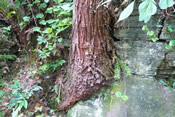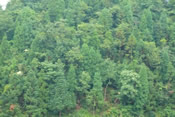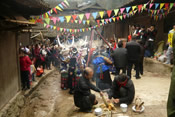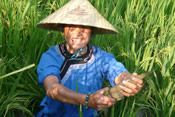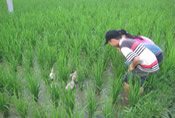By Deng Xunting (Programme Officer [Capacity Building], PCD)

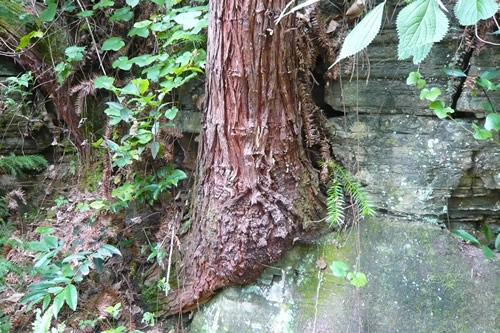 |
| Drawing upon traditional knowledge, villagers of Baixianglin managed to restore the previously destroyed ecological environment by growing trees on rocks. |
Last July I took part in an exchange on traditional culture and ecological conservation at Guiyang in Guizhou Province, China. In Huaxi where the air was fresh and cool, I learnt of a few cases in Guiyang that excited me and refreshed my mind. What was novel about these stories was that they were local, not overseas. How can one not feel excited when one learns that a cultural perspective has finally taken root?
Growing Trees on Rocks
The sharing began with Li Li, head of Guizhou Society for Indigenous Culture Development (GSICD), telling the story of Baixianglin Village. This story undermined my perception of "case". First, it was not about a "programme". It was about how a resilient and vibrant community made miracles.
In the 1980s, the ecological environment of Baixianglin suffered large scale destruction. Experts from outside predicted that it would take a few million yuan and 50 years to restore the ecological environment of Baixianglin. The reality is that the local community has restored over 40,000 mu of forest in 20 years, thanks to a cooperative and a loan of 180,000 yuan.
How did this miracle happen? According to Li Li, traditional culture played a role in at least three ways. First, villagers gained confidence from their traditional knowledge, which told them that it was possible to grow trees on rocks. They also had to have the right method. There was a wealth of local ecological knowledge which guided the villagers in how to plan and grow a forest for ecology and livelihood. For example, local villagers likened trees to human beings: "Trees not only have to eat, they also have to dance." So trees should not be planted too close to each other, but they should also not be planted too far from each other, otherwise they "feel lonely". Ecological restoration also needs systems and mechanisms for long term sustainability. Local traditional Miao organisations and mechanisms as well as traditional ways of discussing public affairs appear to have been particularly important in this respect. Once, a villager cut down some trees surreptitiously. For Miao people, "stealing" is a serious matter. The villagers chose to deal with it by drawing on their traditional wisdom. The village elders said to the logger: "We know you inadvertently cut down some trees. Now you must return the trees to the village and treat everyone to a movie." While the problem was tactfully and smoothly resolved, other villagers also learnt that they must not arbitrarily cut down trees.
This case gives an apt portrayal of the resilience and vibrancy of the community. The story reminds me that the communities in which we work might contain treasures which have not yet been uncovered. When we visit the communities, are we concerned only with completing our tasks? Have we ignored the potential of the communities we visit?
Culture and Economy
Professor Dan Wenhong of Guizhou Normal University was the next to share. She described a programme in a village in Kongbai which was supported by PCD. Kongbai is a rather well-known tourist area in the southeast of Guizhou. Professor Dan first visited Kongbai when she was commissioned to study ways of developing the local silver ornament industry.
Professor Dan proposed the idea of "bringing about economic growth with local culture as the basis". According to this idea, economy is only one of the community functions of culture. Traditional culture has other functions such as realising ecological wisdom, and achieving community integration and social stability. If a community only attaches importance to production, will it be considered as vibrant and sustainable?
A holistic cultural perspective means that silver ornaments are seen not only in relation to people's livelihood. Professor Dan pointed out that once Miao culture, such as the local Gucang Festival, declined, the songs and dances, the costumes and ornaments would all gradually disappear and there would no longer be any room for the tradition of silver craftwork to develop. Because of this, the programme focuses on restoring villagers' cultural self-awareness and self-confidence.
Professor Dan also mentioned the risk of solely considering the economic dimension. The risk was that it would only bring in short term individual gains.
Workshop participants had a lively discussion about this idea. Someone raised the question of whether the elderly people who participated in conserving the legacy of Dong ethnic songs should be paid, since they had contributed their time and effort. The discussion reminded me of the dilemma faced by many community workers. We often see villagers in the community trying hard to earn a living and forced to leave their homes for work in the city. We feel sympathy for them and want to do something to help them. Naturally we think of livelihood projects such as providing training on making silver ornaments or helping villagers find a market for such ornaments.
Professor Dan hit the nail on the head when she cautioned us that paying villagers might alleviate their economic problems or motivate them to participate, but it would ultimately weaken the cultural role of Dong ethnic songs if such songs were seen only as a means to a livelihood. That is why building cultural self-awareness and self-confidence is more important.
The Q & A session brought much insight to the participants. Someone even exclaimed: "Only non-economic motivations are sustainable"!
Culture and Agriculture
Pan Yongrong from PCD was the last speaker for case sharing. He further emphasised the cultural perspective as he highlighted its relationship with agriculture.
In Liufang Village, Liping, PCD used to support a livelihood project that focused on the production and marketing of organic rice. In the first few years of this programme, there were all sorts of problems. Livelihood issues often led to conflicts in the community. Price instability also had an adverse effect on the cultivation of organic rice. The programme team eventually realised that cultural self-awareness (including farming culture) and self-confidence could motivate the villagers. "Without the support of 'culture' as a foundation and without the nourishment provided by culture, no matter how strong a pillar/tree is, it would rot and fall," said Pan.
Some results have been observed since changes were made in the programme. The local Association of Organic Agriculture used to acclaim farmers who were able to sell the most rice. Now they applaud cow-raising farmers who cultivate rice with organic methods!
Between the Traditional and the Modern
Since China began to reform and open up to the outside world, it has embraced globalisation, the power of which has reached even the remotest villages of the country with formidable speed. We were inspired to reflect on the meaning of 'the traditional' and 'the modern' in the workshop case sharing session.
The first insight we gained from the sharing is that when local communities have inherited traditional wisdom, they can interact with the outside world without detriment to the community. At Baixianglin, in restoring their ecology, the community allied traditional knowledge with advice from outside experts.
Pan mentioned that cultural programmes had to take modern demands into consideration. Appropriate modern skills and technologies can be introduced. Methane gas tanks have been built in Liufang Village, for example. Socially, in addition to Dong ethnic songs, modern dances such as 'public square dance' have been introduced from outside of the village to attract villagers who are not interested in singing.
Professor Dan Wenhong pointed out that cultural workers often commit an error in becoming too attached to 'the original ecology'. Village wisdom and values can be found in traditional farm life and forms of production. When the latter disappear, the way of life connected with them changes as well. Villagers have the right to adapt to cultural changes. Outsiders should not expect villagers to preserve the original ecology for so-called cultural tourism.
In other words, 'tradition' is not immutable, and no community is isolated from the outside world. A community is always absorbing outside influences. It selects what it needs from them, and brews a cultural wine of its own.
So-called cultural work, cultural self-awareness and self-confidence may mean appreciating this fine wine of culture together with the villagers, and exploring the core spirit of a vintage that has been brewed for thousands of years. After sampling the wine, the community is able to decide on what it wants to do next and there is no need for outsiders to tell it what to do.


